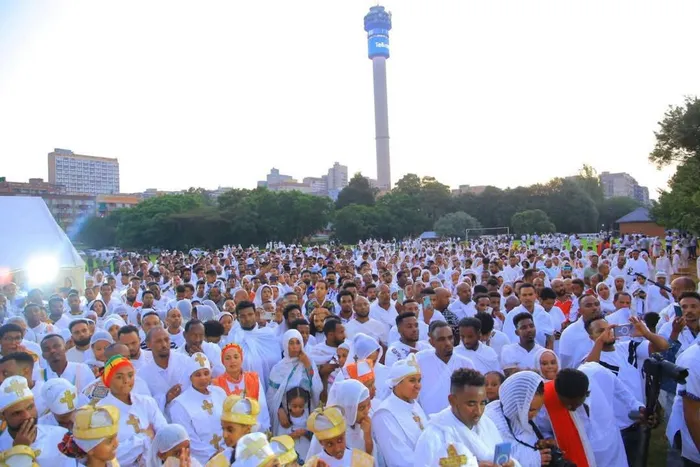South African churches celebrate Timkat with vibrant displays of faith

Scores of Ethiopian Orthodox devotees gathered in Berea, Johannesburg for the celebration of Timkat on Sunday. Picture: Supplied
On Sunday, January 19, the spirit of celebration filled the air as over 45 South African churches, alongside communities worldwide, commemorated Timkat, the Ethiopian Orthodox celebration of the Epiphany. In Berea, Johannesburg, thousands of devotees from the Hadiya Silte South and West Africa Diocese converged at Berea Park, embracing the vivid traditions and rituals that characterise this significant observance.
Timkat is not merely a festival; it is a spiritual spectacle that honours the baptism of Jesus in the River Jordan while signifying a deep commitment to faith and community. The day resonates with vibrant processions, fervent prayers, and the ceremonious blessing of water, symbolising spiritual rejuvenation.
This year, in Ethiopia, the celebration bore special significance as it also honoured healthcare workers tirelessly dedicating their lives to serving their communities.
At the forefront of the Johannesburg festivities was Abune Heryakos, Archbishop of the Hadiya Silte South and West Africa Diocese. He expressed his gratitude to the congregation, stating: “Today we hosted the biggest celebration of the Timkat celebration, and we thank all the members of the Hadiya Silte South and West Africa Diocese for coming in their numbers for the Johannesburg celebrations.”
With a growing membership of approximately 40,000 encompassing over 45 churches spread across South Africa, the event serves as a testament to the thriving Ethiopian Orthodox community in the country.
One of the most majestic representations of Ethiopian Orthodox architecture, the Church of St George (Bete Giyorgis) in Lalibela, showcases the rich cultural heritage behind Timkat.
Carved from rock in the 13th century, Bete Giyorgis features elegantly simple windows decorated with colourful painted icons, earning it a place as a UNESCO World Heritage Site.
Archbishop Heryakos noted, “The celebration is regarded as the largest of all Oriental Orthodox churches' celebrations.”
Lalibela, originally known as Roha, is steeped in history and legend. The town, named after the 12th-century King Gebre Mesqel Lalibela of the Zagwe dynasty, is home to approximately 10,000 inhabitants, among whom are more than 1,000 priests.
According to local lore, King Lalibela, after being poisoned by his brother, entered a death-like stupor and was transported to Heaven. There, he was instructed by God and St George to build the remarkable churches of Lalibela.
During Timkat celebrations, a revered ritual includes the procession of the Tabot, a representation of the Ark of the Covenant, which is treated with utmost respect.
Wrapped in rich cloth, the Tabot is carried aloft on the head of the priest, reaffirming the deep spiritual significance of the day. In 2009, UNESCO recognised Timkat as part of the Representative List of the Intangible Cultural Heritage of Humanity, further preserving its legacy for future generations.
This year’s celebration was not just a reaffirmation of faith but also a heartfelt tribute to those within the community who dedicate their lives to providing care and hope.
As thousands gathered to rejoice in the vibrant colours, faith, and traditions of Timkat, they celebrated their rich heritage and the unwavering spirit of community that furthers the Ethiopian Orthodox Church in South Africa.
siyabonga.sithole@inl.co.za